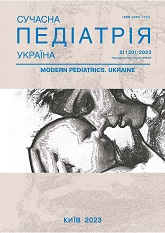Measles: age characteristics of the course
DOI:
https://doi.org/10.15574/SP.2023.130.89Keywords:
measles, viral infection, diagnosis, clinic, complications, childrenAbstract
Purpose - to analyze the clinical and epidemiological features of measles infection in children during the 2017-2018 outbreak in Zaporizhzhia region to increase the alertness of primary care physicians to measles.
Materials and methods. A retrospective analysis of the clinical and epidemiological features of measles infection in 58 children undergoing inpatient treatment in the CNE «Zaporizhzhia Regional Clinical Hospital of Infectious Diseases» of the Zaporizhzhia Regional Council in 2017-2018.
Results. 78.5% of children were hospitalised later than the 3rd day of illness. In the catarrhal period, all children had hyperthermia and the presence of Belsky-Filatov-Koplik spots. The rash lasted 5.3±0.5 days. In all patients, the rash was patchy-papular and spread from top to bottom with the appearance of pigmentation from the 5th day of the disease. All children had a typical form of the disease, in 91.4% of cases - moderate, in 8.6% - severe. 91.4% of children had complications. Among the complications, obstructive bronchitis was more common in infants and young children (р˂0.05), while reactive hepatitis was more common in older children (р˂0.05).
Conclusions. During the outbreak of measles in Ukraine (in 2017-2018), the course of the disease was typical. Obstructive bronchitis was the most frequent complication in children of early age, reactive hepatitis - in older children.
The research was carried out in accordance with the principles of the Declaration of Helsinki. Informed consent of the children’s parents was obtained for the study.
No conflict of interests was declared by the authors.
References
Aaby P, Martins CL, Ravn H, Rodrigues A, Whittle HC, Benn CS. (2015). Is early measles vaccination better than later measles vaccination? Transactions of the Royal Society of Tropical Medicine and Hygiene. 109 (1): 16-28. https://doi.org/10.1093/trstmh/tru174; PMid:25573106
Bilokobyla SO, Ryabokon OV, Riabokon YuYu, Onishchenko NV. (2020). Characteristics of serological profile in adult measles patients depending on the development of complications. Zaporozhye medical journal. 22 (6): 823-827. https://doi.org/10.14739/2310-1210.2020.6.218457
Chen HL, Tang RB. (2020). Measles re-emerges and recommendation of vaccination. Journal of the Chinese Medical Association: JCMA. 83 (1): 5-7. https://doi.org/10.1097/JCMA.0000000000000210; PMid:31569091
Crecelius EM, Burnett MW. (2020). Measles (Rubeola): An Update. Journal of special operations medicine: A peer reviewed journal for SOF medical professionals. 20 (2): 136-138. https://doi.org/10.55460/3NFC-341T; PMid:32573751
Gianniki M, Siahanidou T, Botsa E, Michos A. (2021). Measles epidemic in pediatric population in Greece during 2017-2018: Epidemiological, clinical characteristics and outcomes. PloS one. 16 (1): e0245512. https://doi.org/10.1371/journal.pone.0245512; PMid:33471833 PMCid:PMC7817010
Kakoullis L, Sampsonas F, Giannopoulou E, Kalogeropoulou C, Papachristodoulou E, Tsiamita M et al. (2020). Measles-associated pneumonia and hepatitis during the measles outbreak of 2018. International journal of clinical practice. 74 (2): e13430. https://doi.org/10.1111/ijcp.13430; PMid:31573732
Khyts AR. (2019). Measles in Ukraine. Ukrainskyi medychnyi chasopys. URL: https://www.umj.com.ua/article/164085/kir-v-ukrayini.
Kramarov SO, Yevtushenko VV, Kovalyukh IYu, Kaminska TM, Golovach OV. (2018). Clinical features of measles in children hospitalized during 2017-2018 outbreak. Actual infectology. 6 (5): 240-245. https://doi.org/10.22141/2312-413x.6.5.2018.146773
Kumari PL, Kutty AM. (2021). Measles Specific Immunoglobulin G Response in Children Aged 4-12 Year Who Received Two Doses of Measles Containing Vaccine in Infancy. Indian pediatrics. 58 (3): 250-252. URL: https://pubmed.ncbi.nlm.nih.gov/33713061/. https://doi.org/10.1007/s13312-021-2165-y; PMid:33713061
Nehrych T, Shorobura M, Hritsyna I, Yukhimiv L, Kyryliuk S. (2021). Peculiarities of the clinical course of postmeasles encephalitis in immunosupressed people. Proceeding of the Shevchenko Scientific Society. Medical Sciences. 64 (1): 62-70. https://doi.org/10.25040/ntsh2021.01.06
Satoh A, Kobayashi H, Yoshida T, Tanaka A, Kawajiri T, Oki Y et al. (1999). Clinicopathological study on liver dysfunction in measles. Internal medicine (Tokyo, Japan). 38 (5): 454-457. https://doi.org/10.2169/internalmedicine.38.454; PMid:10397088
Sindhu TG, Geeta MG, Krishnakumar P, Sabitha S, Ajina KK. (2019). Clinical profile of measles in children with special reference to infants. Tropical doctor. 49 (1): 20-23. https://doi.org/10.1177/0049475518804695; PMid:30319076
Usachova OV, Silina YeA, Pakholchuk TN, Konakova OV et al. (2019). Measles - controlled infection! Some epidemiological paradigm of measles in Zaporizhzhia region. Sovremennaya pediatriya. 1 (97): 13-18. https://doi.org/10.15574/SP.2019.97.13
World Health Organization. (2019). Measles - European Region. URL: http://www.euro.who.int/ru/media-centre/sections/press-releases/2018/measles-cases-hit-record-high-in-the-european-region.
Yan R, He H, Zhou Y, Xie S, Deng X, Tang X. (2019). Study on factors associated with seroprotection after measles vaccination in children of 6-14 years in Eastern China. Vaccine. 37 (36): 5185-5190. https://doi.org/10.1016/j.vaccine.2019.07.075; PMid:31377078
Yudin IP, Kuchma IY, Volyanskiy AY. (2019). Seroprevalence of anti-measles igg in the population of Kharkiv region in 2018-2019. Immunology and allergology: Science and practice. 4: 22-25. https://doi.org/10.37321/immunology.2019.04-03
Downloads
Published
Issue
Section
License
Copyright (c) 2023 Modern pediatrics. Ukraine

This work is licensed under a Creative Commons Attribution-NonCommercial 4.0 International License.
The policy of the Journal “MODERN PEDIATRICS. UKRAINE” is compatible with the vast majority of funders' of open access and self-archiving policies. The journal provides immediate open access route being convinced that everyone – not only scientists - can benefit from research results, and publishes articles exclusively under open access distribution, with a Creative Commons Attribution-Noncommercial 4.0 international license (СС BY-NC).
Authors transfer the copyright to the Journal “MODERN PEDIATRICS. UKRAINE” when the manuscript is accepted for publication. Authors declare that this manuscript has not been published nor is under simultaneous consideration for publication elsewhere. After publication, the articles become freely available on-line to the public.
Readers have the right to use, distribute, and reproduce articles in any medium, provided the articles and the journal are properly cited.
The use of published materials for commercial purposes is strongly prohibited.

